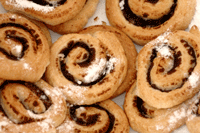One of the most common reactions when we’re feeling down is to reach for something to eat. Our research showed that up to 75% of people instinctively reach for comfort food, when they’re feel down, stressed or angry.
Yet what we’re eating (or drinking) could be making us feel worse.
Discover the 5 most common food traps that could be wrecking your mood.
 Trap 1: Sugar
Trap 1: Sugar
Reaching for something sweet when we’re feeling low is so instinctive, you’d almost think it’s hard-wired.
Carbohydrates and refined sugars will give us a short-term boost, but the blood sugar low we get afterwards can lead to mood swings and even tantrums in kids.
What you could do instead?
University researchers have shown that cravings for sweet foods, particularly the late night munchies, are actually cravings for water – we’re not very good at reading the signs.
To balance your blood sugar, a protein-based snack may be more helpful. You could try that first.
Trap 2: Caffeine
It’s in coffee, tea, cola drinks and plenty more besides. Caffeine is a stimulant that can take us into “fight or flight” mode, making us edgy and irritable. So if you’re already stressed or angry, it’s the last thing you need.
What you could do instead?
To rehydrate your system and give yourself an instant energy boost, a glass of cool water could make a difference. If you’re feeling tense and irritable, you might prefer camomile tea. And, of course, there’s breathing – take 3 deep breaths, breathing in through your nose. Fill your lungs from your stomach upwards and then breathe out through your mouth with a sigh. It works!
Trap 3: Sweeteners & Additives
We think we’re doing the right thing by going for the low-cal, low-fat options, but they have to do something to replace the taste and texture you’d have had from the sugars and fats. Unfortunately this is often in the form of sweeteners and chemical additives.
Yes, the various food agencies have approved their use, but there is growing research evidence that they can impact your mood.
One of the leading artificial sweeteners is now official linked with mood swings and even depression, for regular users. And we’ve known for years that the infamous “e-numbers” can cause behavioural problems in children.
What you could do instead?
Check labels in the supermarket. As a rule of thumb, if there’s an ingredient on the list that you wouldn’t cook with at home, think twice before putting it into your basket.
Consider buying the non-diet versions, but eating less of them…
Trap 4: Alcohol
How many times do we get to the end of a tough day and think, “I could really do with a glass of wine / a beer?”
And there has been research showing that some alcoholic drinks can have health benefits, in moderation.
But alcohol itself is a toxin to the body. And it’s also a depressant that suppresses brain activity and dehydrates your body. So if you want to feel happier, a stiff drink is probably not the best place to start.
What you could do instead?
Drink a glass of water between each alcoholic drink. And it might be worth taking an honest look in the mirror, to see whether there are underlying issues you might need to address.
Trap 5: Wheat & dairy
Wheat and dairy products are fine, in moderation. But if you have a food intolerance, you might find that the side effects of bloating and heaviness drag your mood down, too. So if you naturally reach for wheat-based or dairy-based comfort foods, it might be worth noticing how you feel afterwards.
What you could do instead?

By the way, my ALL TIME FAVOURITE book about the impact wheat really has on our body, mind and spirit is ‘Wheat Belly’ by William Davis M.D. Reading this book changed my life and set me free from decades of feeling rough, but nothing working to ‘fix’ things.
How do you know if you’re stuck in the food traps?
Keep a “food ‘n’ mood” diary for 2 weeks.
Simply keep a note of EVERYTHING you’re eating and drinking (no cheating!) and every few hours, make a note of your mood next to it. After even a week you should be able to spot clear trends.
That’ll help you figure out what to eat differently, if you want to feel happier.
What have you noticed about how your mood swings after eating and drinking? Is there any advice you’d like to share with others, via the comments box?
And if you’d like some moral support on breaking some of the mood-wrecking food habits, how about making sure you’re getting my newsletter – it also gets you GIFT membership of our private Facebook group?
With love, Namaste,
![]()

Great check list, Clare, thanks! It’s amazing how often I try to fix a low mood with a cup of coffee. Every now and again I catch myself and have a glass of fizzy water instead (I can’t stand still water!). I ALWAYS feel zingy and energised after that. And usually I feel irritable and even more slump-y after the coffee. Old habits really do die hard. But they do die, I hope : )